

Compact Muon Solenoid
LHC, CERN
| CMS-HIN-14-005 ; CERN-EP-2016-243 | ||
| Suppression and azimuthal anisotropy of prompt and nonprompt $ \mathrm{J}/\psi $ production in PbPb collisions at $\sqrt{s_{\mathrm{NN}}} = $ 2.76 TeV | ||
| CMS Collaboration | ||
| 3 October 2016 | ||
| Eur. Phys. J. C 77 (2017) 252 | ||
| Abstract: The nuclear modification factor ${R_{\mathrm{AA}}} $ and the azimuthal anisotropy coefficient ${v_{2}} $ of prompt and nonprompt (i.e. those from decays of b hadrons) $\mathrm{J}/\psi$ mesons, measured from PbPb and pp collisions at $\sqrt{s_{\mathrm{NN}}} = $ 2.76 TeV at the LHC, are reported. The results are presented in several event centrality intervals and several kinematic regions, for transverse momenta $p_{\mathrm{T}} > $ 6.5 GeV/$c$ and rapidity $| {y} | < $ 2.4, extending down to $p_{\mathrm{T}}= $ 3 GeV/$c$ in the 1.6 $ < |{y}| < $ 2.4 range. The ${v_{2}} $ of prompt $\mathrm{J}/\psi$ is found to be nonzero and constant over the full kinematic range studied, while the measured ${v_{2}} $ of nonprompt $\mathrm{J}/\psi$ is consistent with zero. The ${R_{\mathrm{AA}}} $of prompt $\mathrm{J}/\psi$ exhibits a suppression that increases with centrality but does not vary as a function of either $y$ or $p_{\mathrm{T}}$ in the fiducial range. The nonprompt $\mathrm{J}/\psi$ $ {R_{\mathrm{AA}}} $ shows a suppression which becomes stronger as rapidity or $ p_{\mathrm{T}}$ increase. The ${v_{2}} $ and nuclear suppression of open and hidden charm, and of open charm and beauty, are compared. | ||
| Links: e-print arXiv:1610.00613 [nucl-ex] (PDF) ; CDS record ; inSPIRE record ; HepData record ; CADI line (restricted) ; | ||
| Figures & Tables | Summary | Additional Figures | References | CMS Publications |
|---|
| Figures | |
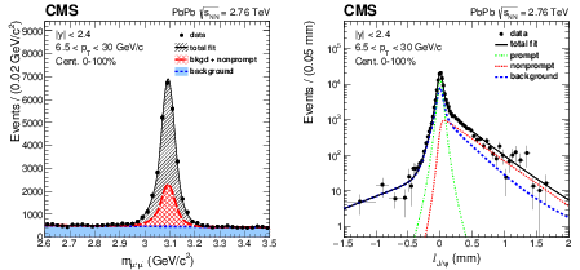
png pdf |
Figure 1:
Invariant mass spectra (left) and pseudo-proper decay length distribution (right) of ${\mu^+ \mu^- }$ pairs in centrality 0-100% and integrated over the rapidity range $ {| y | }< $ 2.4 and the $ {p_{\mathrm {T}}} $ range 6.5 $ < {p_{\mathrm {T}}} < $ 30 GeV/$c$. The error bars on each point represent statistical uncertainties. The projections of the two-dimensional fit onto the respective axes are overlaid as solid black lines. The dashed green and red lines show the fitted contribution of prompt and nonprompt $ \mathrm{J}/\psi $. The fitted background contributions are shown as dotted blue lines. |

png pdf |
Figure 1-a:
Invariant mass spectra of ${\mu^+ \mu^- }$ pairs in centrality 0-100% and integrated over the rapidity range $ {| y | }< $ 2.4 and the ${p_{\mathrm {T}}}$ range 6.5 $ < {p_{\mathrm {T}}} < $ 30 GeV/$c$. The error bars on each point represent statistical uncertainties. The projections of the two-dimensional fit onto the respective axes are overlaid as solid black lines. The dashed green and red lines show the fitted contribution of prompt and nonprompt $ \mathrm{J}/\psi $. The fitted background contributions are shown as dotted blue lines. |
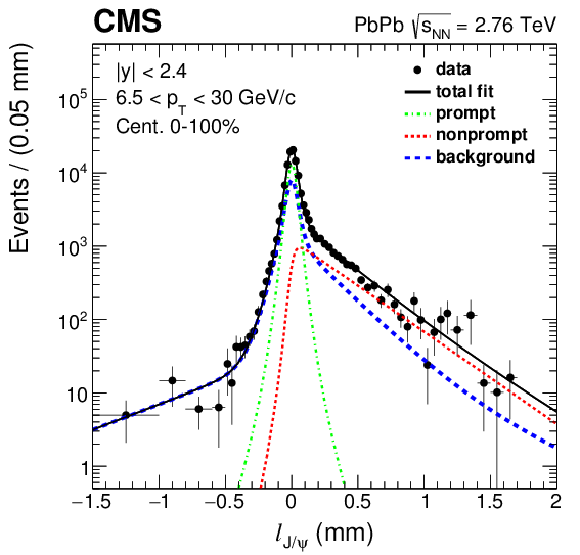
png pdf |
Figure 1-b:
Pseudo-proper decay length distribution of ${\mu^+ \mu^- }$ pairs in centrality 0-100% and integrated over the rapidity range $ {| y | }< $ 2.4 and the ${p_{\mathrm {T}}}$ range 6.5 $ < {p_{\mathrm {T}}} < $ 30 GeV/$c$. The error bars on each point represent statistical uncertainties. The projections of the two-dimensional fit onto the respective axes are overlaid as solid black lines. The dashed green and red lines show the fitted contribution of prompt and nonprompt $ \mathrm{J}/\psi $. The fitted background contributions are shown as dotted blue lines. |
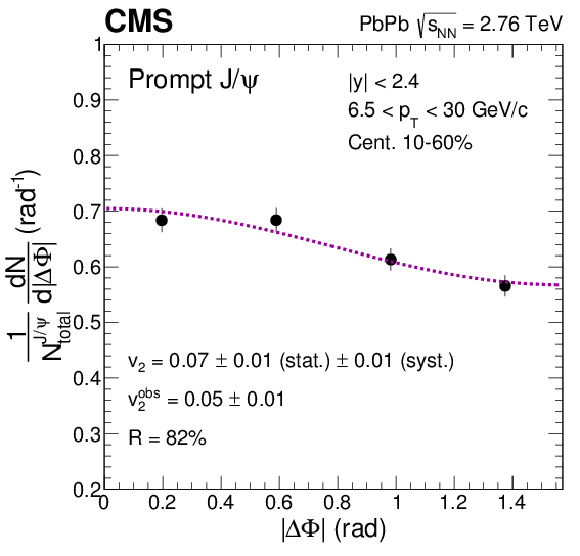
png pdf |
Figure 2:
The $ {| \Delta \Phi | }$ distribution of high $ {p_{\mathrm {T}}} $ prompt $ \mathrm{J}/\psi $ mesons, 6.5 $ < {p_{\mathrm {T}}} < $ 30 GeV/$c$, measured in the rapidity range $ {| y | } < $ 2.4 and event centrality 10-60%, normalized by the bin width and the sum of the prompt yields in all four $\Delta \Phi $ bins. The dashed line represents the function $1+2 {v_{2}} ^{\text {obs}} \cos({| 2 {\Delta \Phi } | })$ used to extract the $ {v_{2}} ^{\text {obs}}$. The event-averaged resolution correction factor, corresponding to this event centrality, is also listed, together with the calculated final $ {v_{2}} $ for this kinematic bin. The systematic uncertainty listed in the legend includes the 2.7% global uncertainty from the event plane measurement. |

png pdf |
Figure 3:
Prompt $ \mathrm{J}/\psi $ $ {v_{2}} $ as a function of centrality (upper left), rapidity (upper right), and $ {p_{\mathrm {T}}} $ (bottom). The bars (boxes) represent statistical (systematic) point-by-point uncertainties. The global uncertainty, listed in the legend, is not included in the point-by-point uncertainties. Horizontal bars indicate the bin width. The average $ {N_{\text {part}}} $ values correspond to events flatly distributed across centrality. |

png pdf |
Figure 3-a:
Prompt $ \mathrm{J}/\psi $ $ {v_{2}} $ as a function of centrality. The bars (boxes) represent statistical (systematic) point-by-point uncertainties. Horizontal bars indicate the bin width. The average $ {N_{\mathrm {part}}} $ values correspond to events flatly distributed across centrality. |

png pdf |
Figure 3-b:
Prompt $ \mathrm{J}/\psi $ $ {v_{2}} $ as a function of rapidity. The bars (boxes) represent statistical (systematic) point-by-point uncertainties. Horizontal bars indicate the bin width. The average $ {N_{\mathrm {part}}} $ values correspond to events flatly distributed across centrality. |
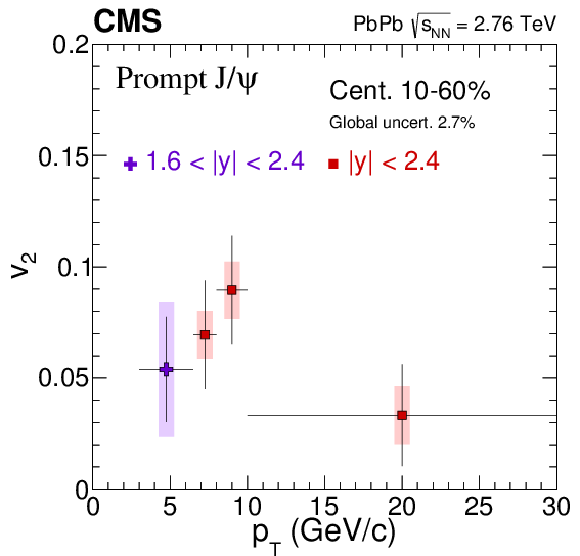
png pdf |
Figure 3-c:
Prompt $ \mathrm{J}/\psi $ $ {v_{2}} $ as a function of $ {p_{\mathrm {T}}} $. The bars (boxes) represent statistical (systematic) point-by-point uncertainties. Horizontal bars indicate the bin width. The average $ {N_{\mathrm {part}}} $ values correspond to events flatly distributed across centrality. |

png pdf |
Figure 4:
Prompt $ \mathrm{J}/\psi $ $ {R_{\mathrm {AA}}} $ as a function of centrality (upper left), rapidity (upper right), and $ {p_{\mathrm {T}}} $ (bottom). The bars (boxes) represent statistical (systematic) point-by-point uncertainties. The gray boxes plotted on the right side at $ {R_{\mathrm {AA}}} = $ 1 represent the scale of the global uncertainties. The average $ {N_{\text {part}}} $ values correspond to events flatly distributed across centrality. |
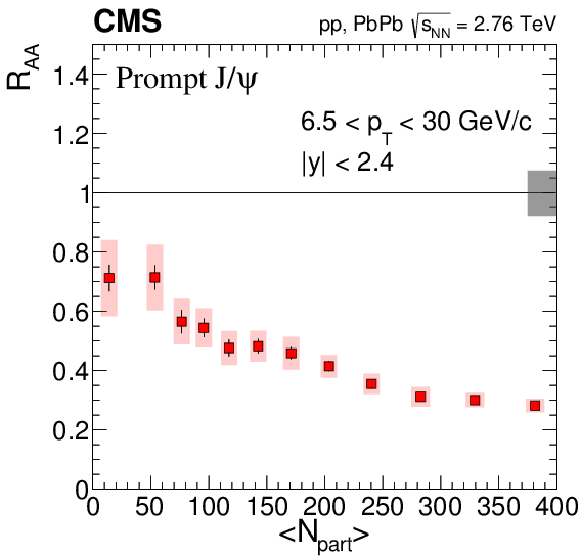
png pdf |
Figure 4-a:
Prompt $ \mathrm{J}/\psi $ $ {R_{\mathrm {AA}}} $ as a function of centrality. The bars (boxes) represent statistical (systematic) point-by-point uncertainties. The gray boxes plotted on the right side at $ {R_{\mathrm {AA}}} = $ 1 represent the scale of the global uncertainties. The average $ {N_{\mathrm {part}}} $ values correspond to events flatly distributed across centrality. |
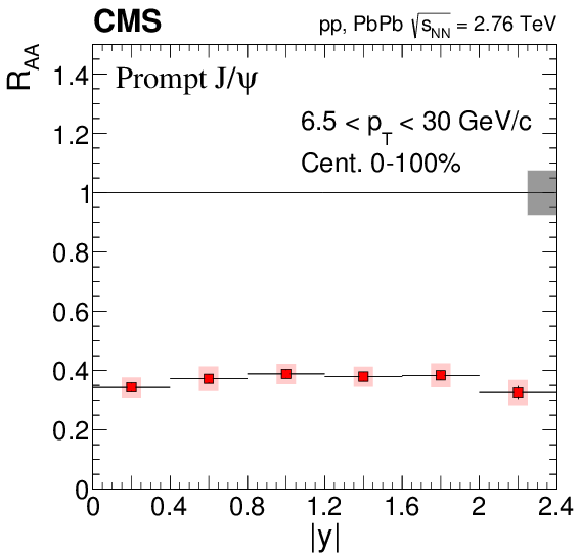
png pdf |
Figure 4-b:
Prompt $ \mathrm{J}/\psi $ $ {R_{\mathrm {AA}}} $ as a function of rapidity. The bars (boxes) represent statistical (systematic) point-by-point uncertainties. The gray boxes plotted on the right side at $ {R_{\mathrm {AA}}} = $ 1 represent the scale of the global uncertainties. The average $ {N_{\mathrm {part}}} $ values correspond to events flatly distributed across centrality. |

png pdf |
Figure 4-c:
Prompt $ \mathrm{J}/\psi $ $ {R_{\mathrm {AA}}} $ as a function of $ {p_{\mathrm {T}}} $. The bars (boxes) represent statistical (systematic) point-by-point uncertainties. The gray boxes plotted on the right side at $ {R_{\mathrm {AA}}} = $ 1 represent the scale of the global uncertainties. The average $ {N_{\mathrm {part}}} $ values correspond to events flatly distributed across centrality. |
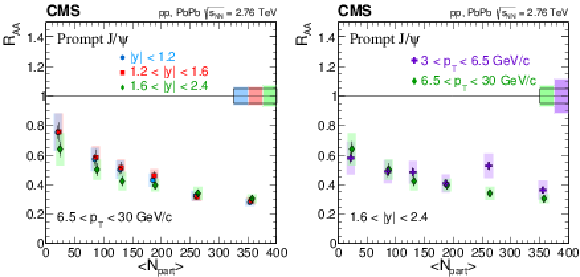
png pdf |
Figure 5:
(left) Prompt $ \mathrm{J}/\psi $ $ {R_{\mathrm {AA}}} $ as a function of centrality at high $ {p_{\mathrm {T}}} $, 6.5 $ < {p_{\mathrm {T}}} < $ 30 GeV/$c$, for three different $ {| y | }$ regions. The high- $ {p_{\mathrm {T}}} $ mid- and forward-rapidity points are shifted horizontally by $\Delta {N_{\text {part}}} = $ 2 for better visibility. (right) Prompt $ \mathrm{J}/\psi $ $ {R_{\mathrm {AA}}} $ as a function of centrality, at forward rapidity, 1.6 $ < {| y | } < $ 2.4, for two different $ {p_{\mathrm {T}}} $ regions. The bars (boxes) represent statistical (systematic) point-by-point uncertainties. The boxes plotted on the right side at $ {R_{\mathrm {AA}}} = $ 1 represent the scale of the global uncertainties: the coloured boxes show the statistical and systematic uncertainties from pp measurement, and the open box shows the global uncertainties common to all data points. The average $ {N_{\text {part}}} $ values correspond to events flatly distributed across centrality. |
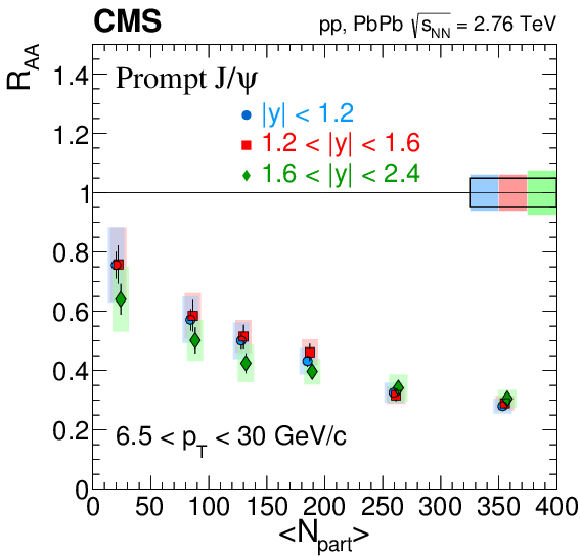
png pdf |
Figure 5-a:
Prompt $ \mathrm{J}/\psi $ $ {R_{\mathrm {AA}}} $ as a function of centrality at high $ {p_{\mathrm {T}}} $, 6.5 $ < {p_{\mathrm {T}}} < $ 30 GeV/$c$, for three different $ {| y | }$ regions. The bars (boxes) represent statistical (systematic) point-by-point uncertainties. The boxes plotted on the right side at $ {R_{\mathrm {AA}}} = $ 1 represent the scale of the global uncertainties: the coloured boxes show the statistical and systematic uncertainties from pp measurement, the open box shows the global uncertainties common to all data points. The average $ {N_{\mathrm {part}}} $ values correspond to events flatly distributed across centrality. |

png pdf |
Figure 5-b:
Prompt $ \mathrm{J}/\psi $ $ {R_{\mathrm {AA}}} $ as a function of centrality, at forward rapidity, 1.6 $ < {| y | }< $ 2.4, for two different $ {p_{\mathrm {T}}} $ regions. The bars (boxes) represent statistical (systematic) point-by-point uncertainties. The boxes plotted on the right side at $ {R_{\mathrm {AA}}} = $ 1 represent the scale of the global uncertainties: the coloured boxes show the statistical and systematic uncertainties from pp measurement, the open box shows the global uncertainties common to all data points. The average $ {N_{\mathrm {part}}} $ values correspond to events flatly distributed across centrality. |

png pdf |
Figure 6:
Nonprompt $ \mathrm{J}/\psi $ $ {v_{2}} $ as a function of $ {p_{\mathrm {T}}} $. The bars (boxes) represent statistical (systematic) point-by-point uncertainties. The global uncertainty, listed in the legend, is not included in the point-by-point uncertainties. Horizontal bars indicate the bin width. |

png pdf |
Figure 7:
Nonprompt $ \mathrm{J}/\psi $ $ {R_{\mathrm {AA}}} $ as a function of centrality (upper left), rapidity (upper right), and $ {p_{\mathrm {T}}} $ (bottom). The bars (boxes) represent statistical (systematic) point-by-point uncertainties. The gray boxes plotted on the right side at $ {R_{\mathrm {AA}}} = $ 1 represent the scale of the global uncertainties. For $ {R_{\mathrm {AA}}} $ vs. $ {N_{\text {part}}} $, the average $ {N_{\text {part}}} $ values correspond to events flatly distributed across centrality. |

png pdf |
Figure 7-a:
Nonprompt $ \mathrm{J}/\psi $ $ {R_{\mathrm {AA}}} $ as a function of centrality. The bars (boxes) represent statistical (systematic) point-by-point uncertainties. The gray boxes plotted on the right side at $ {R_{\mathrm {AA}}} =$ 1 represent the scale of the global uncertainties. For $ {R_{\mathrm {AA}}} $ vs. $ {N_{\mathrm {part}}} $, the average $ {N_{\mathrm {part}}} $ values correspond to events flatly distributed across centrality. |
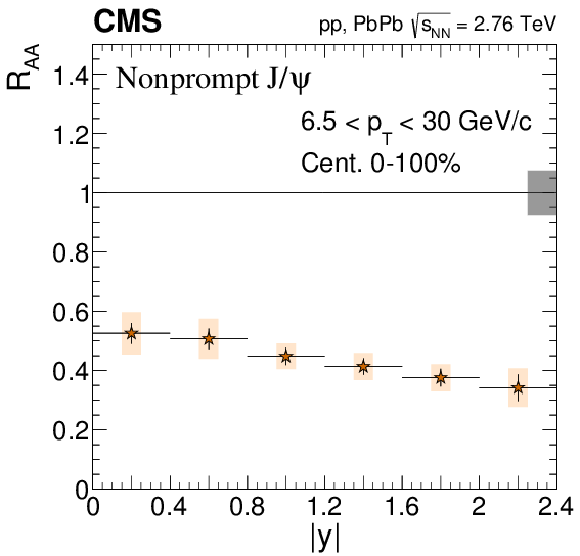
png pdf |
Figure 7-b:
Nonprompt $ \mathrm{J}/\psi $ $ {R_{\mathrm {AA}}} $ as a function of rapidity. The bars (boxes) represent statistical (systematic) point-by-point uncertainties. The gray boxes plotted on the right side at $ {R_{\mathrm {AA}}} =$ 1 represent the scale of the global uncertainties. For $ {R_{\mathrm {AA}}} $ vs. $ {N_{\mathrm {part}}} $, the average $ {N_{\mathrm {part}}} $ values correspond to events flatly distributed across centrality. |

png pdf |
Figure 7-c:
Nonprompt $ \mathrm{J}/\psi $ $ {R_{\mathrm {AA}}} $ as a function of $ {p_{\mathrm {T}}} $. The bars (boxes) represent statistical (systematic) point-by-point uncertainties. The gray boxes plotted on the right side at $ {R_{\mathrm {AA}}} =$ 1 represent the scale of the global uncertainties. For $ {R_{\mathrm {AA}}} $ vs. $ {N_{\mathrm {part}}} $, the average $ {N_{\mathrm {part}}} $ values correspond to events flatly distributed across centrality. |
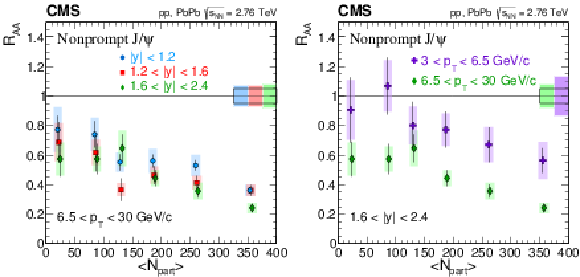
png pdf |
Figure 8:
(left) Nonprompt $ \mathrm{J}/\psi $ $ {R_{\mathrm {AA}}} $ as a function of centrality at high $ {p_{\mathrm {T}}} $, 6.5 $ < {p_{\mathrm {T}}} < $ 30 GeV/$c$, for three different $ {| y | }$ regions. The high- $ {p_{\mathrm {T}}} $ mid- and forward-rapidity points are shifted horizontally by $\Delta {N_{\text {part}}} = $ 2 for better visibility. (right) Nonprompt $ \mathrm{J}/\psi $ $ {R_{\mathrm {AA}}} $ as a function of centrality, at forward rapidity, 1.6 $ < {| y | } < $ 2.4, for two different $ {p_{\mathrm {T}}} $ regions. The bars (boxes) represent statistical (systematic) point-by-point uncertainties. The boxes plotted on the right side at $ {R_{\mathrm {AA}}} = $ 1 represent the scale of the global uncertainties: the coloured boxes show the statistical and systematic uncertainties from pp measurement, and the open box shows the global uncertainties common to all data points. The average $ {N_{\text {part}}} $ values correspond to events flatly distributed across centrality. |

png pdf |
Figure 8-a:
Nonprompt $ \mathrm{J}/\psi $ $ {R_{\mathrm {AA}}} $ as a function of centrality at high $ {p_{\mathrm {T}}} $, 6.5 $ < {p_{\mathrm {T}}} < $ 30 GeV/$c$, for three different $ {| y | }$ regions. The bars (boxes) represent statistical (systematic) point-by-point uncertainties. The boxes plotted on the right side at $ {R_{\mathrm {AA}}} =$ 1 represent the scale of the global uncertainties: the coloured boxes show the statistical and systematic uncertainties from pp measurement, and the open box shows the global uncertainties common to all data points. The average $ {N_{\mathrm {part}}} $ values correspond to events flatly distributed across centrality. |
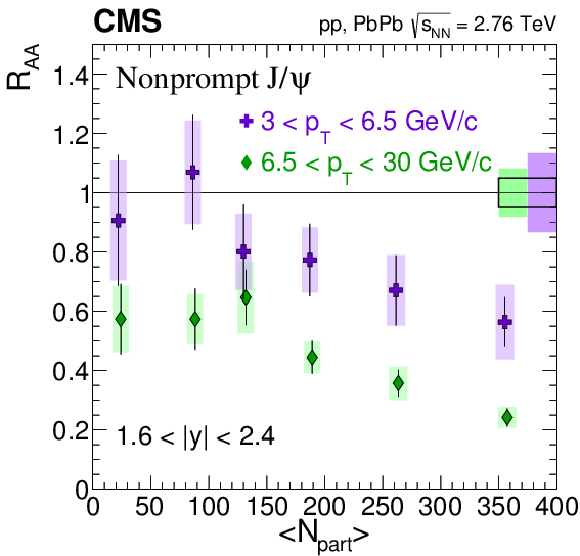
png pdf |
Figure 8-b:
Nonprompt $ \mathrm{J}/\psi $ $ {R_{\mathrm {AA}}} $ as a function of centrality, at forward rapidity, 1.6 $ < {| y | }< $ 2.4, for two different $ {p_{\mathrm {T}}} $ regions. The bars (boxes) represent statistical (systematic) point-by-point uncertainties. The boxes plotted on the right side at $ {R_{\mathrm {AA}}} =$ 1 represent the scale of the global uncertainties: the coloured boxes show the statistical and systematic uncertainties from pp measurement, and the open box shows the global uncertainties common to all data points. The average $ {N_{\mathrm {part}}} $ values correspond to events flatly distributed across centrality. |
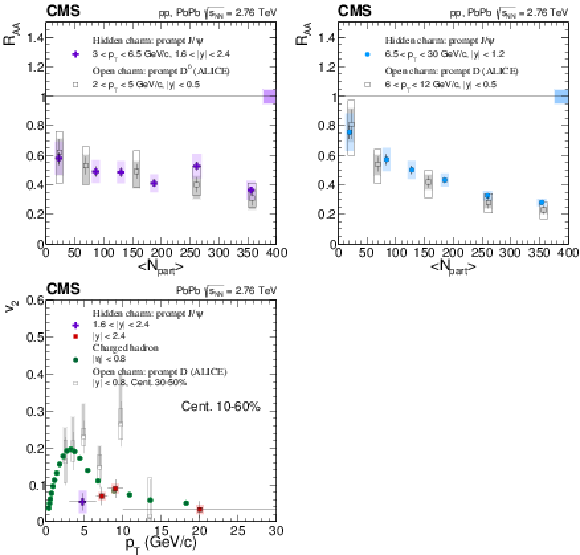
png pdf |
Figure 9:
Prompt $ \mathrm{J}/\psi $ and D meson ([61]) $ {R_{\mathrm {AA}}} $ vs. centrality for low $ {p_{\mathrm {T}}} $ (upper left) and high $ {p_{\mathrm {T}}} $ (upper right). The average $ {N_{\text {part}}} $ values correspond to events flatly distributed across centrality. (bottom) Prompt $ \mathrm{J}/\psi $ and D meson ([31]), and charged hadron ([60,58]) $ {v_{2}} $ vs. $ {p_{\mathrm {T}}} $. |
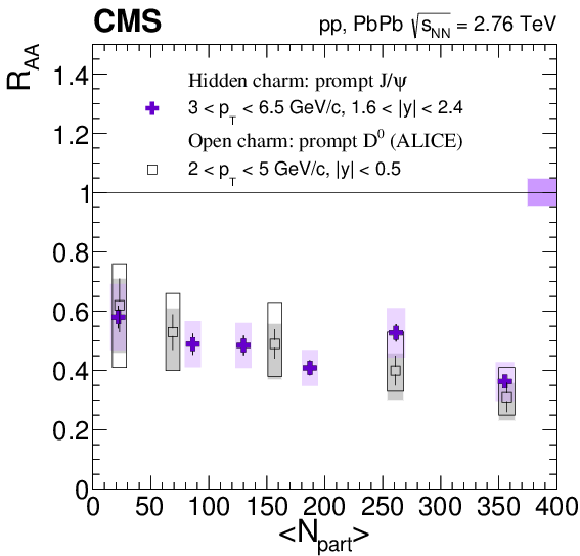
png pdf |
Figure 9-a:
Prompt $ \mathrm{J}/\psi $ and D meson ([61]) $ {R_{\mathrm {AA}}} $ vs. centrality for low $ {p_{\mathrm {T}}} $. The average $ {N_{\mathrm {part}}} $ values correspond to events flatly distributed across centrality. |
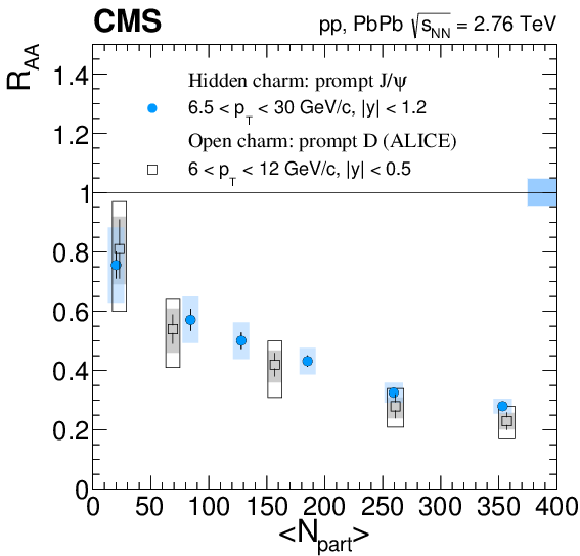
png pdf |
Figure 9-b:
Prompt $ \mathrm{J}/\psi $ and D meson ([61]) $ {R_{\mathrm {AA}}} $ vs. centrality for high $ {p_{\mathrm {T}}} $. The average $ {N_{\mathrm {part}}} $ values correspond to events flatly distributed across centrality. |
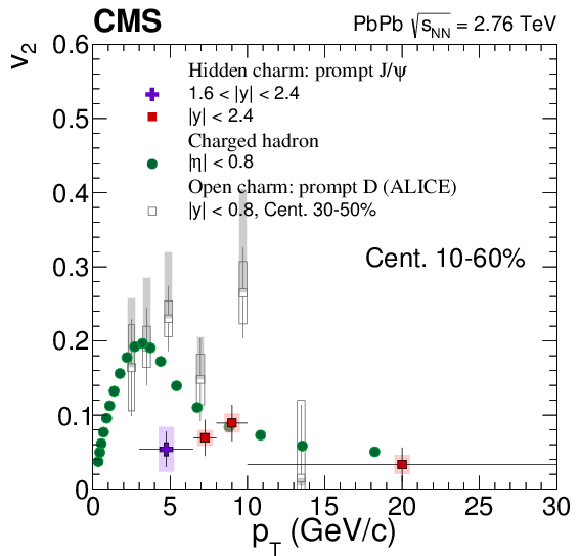
png pdf |
Figure 9-c:
Prompt $ \mathrm{J}/\psi $ and D meson ([31]), and charged hadron ([59,57]) $ {v_{2}} $ vs. $ {p_{\mathrm {T}}} $. |
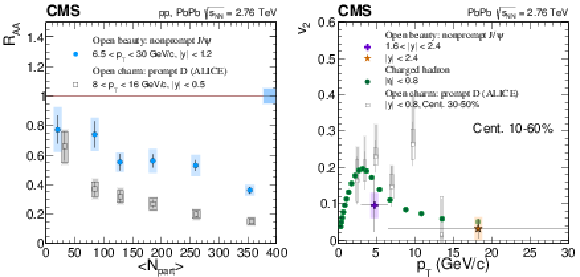
png pdf |
Figure 10:
Nonprompt $ \mathrm{J}/\psi $ and prompt D meson ([62,31]), and charged hadron ([60,58]) $ {R_{\mathrm {AA}}} $ vs. centrality (left), and $ {v_{2}} $ vs. $ {p_{\mathrm {T}}} $ (right). For the left plot, the average $ {N_{\text {part}}} $ values correspond to events flatly distributed across centrality. |
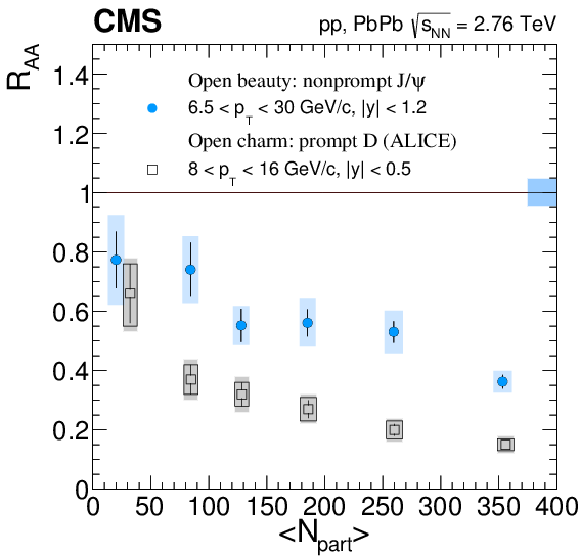
png pdf |
Figure 10-a:
Nonprompt and D meson ([62,31]), and charged hadron ([59,57]) $ {R_{\mathrm {AA}}} $ vs. centrality. The average $ {N_{\mathrm {part}}} $ values correspond to events flatly distributed across centrality. |
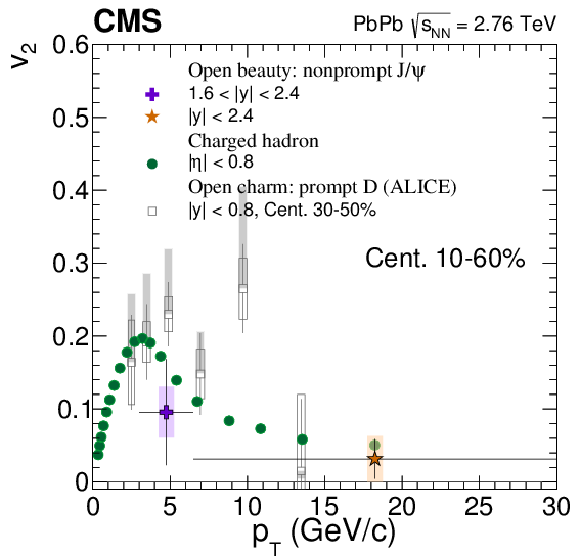
png pdf |
Figure 10-b:
Nonprompt and D meson ([62,31]), and charged hadron ([59,57]) $ {v_{2}} $ vs. $ {p_{\mathrm {T}}} $. |
| Tables | |
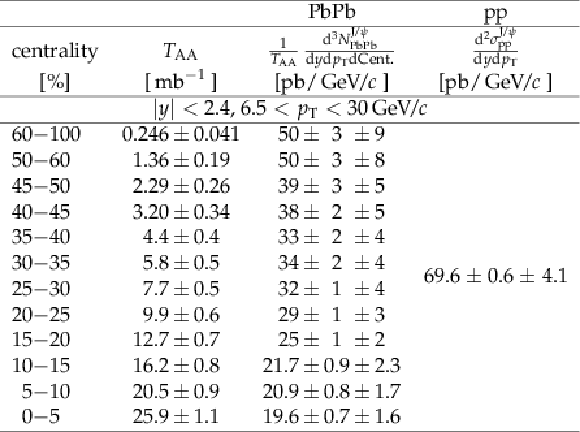
png pdf |
Table 1:
The prompt $ \mathrm{J}/\psi $ fiducial cross section in bins of centrality, measured in PbPb and pp collisions at 2.76 TeV within the muon acceptance defined by Eq. (4), and the nuclear overlap function ($ {T_{\mathrm {AA}}} $, with its systematic uncertainty). Listed uncertainties are statistical first and systematic second. A global systematic uncertainty of 3.2% (3.7%) affects all PbPb (pp) fiducial cross sections. The table corresponds to the top panel of Fig. 4. |

png pdf |
Table 2:
The prompt $ \mathrm{J}/\psi $ fiducial cross section in bins of absolute rapidity, measured in PbPb and pp collisions at 2.76 TeV within the muon acceptance defined by Eq. (4), and the nuclear overlap function ($ {T_{\mathrm {AA}}} $, with its systematic uncertainty). Listed uncertainties are statistical first and systematic second. A global systematic uncertainty of 6.5% (3.7%) affects all PbPb (pp) fiducial cross sections. The table corresponds to the middle panel of Fig. 4. |

png pdf |
Table 3:
The prompt $ \mathrm{J}/\psi $ fiducial cross section in bins of $ {p_{\mathrm {T}}} $, measured in PbPb and pp collisions at 2.76 TeV within the muon acceptance defined by Eq. (4), and the nuclear overlap function ($ {T_{\mathrm {AA}}} $, with its systematic uncertainty). Listed uncertainties are statistical first and systematic second. A global systematic uncertainty of 6.5% (3.7%) affects all PbPb (pp) fiducial cross sections. The table corresponds to the bottom panel of Fig. 4. |
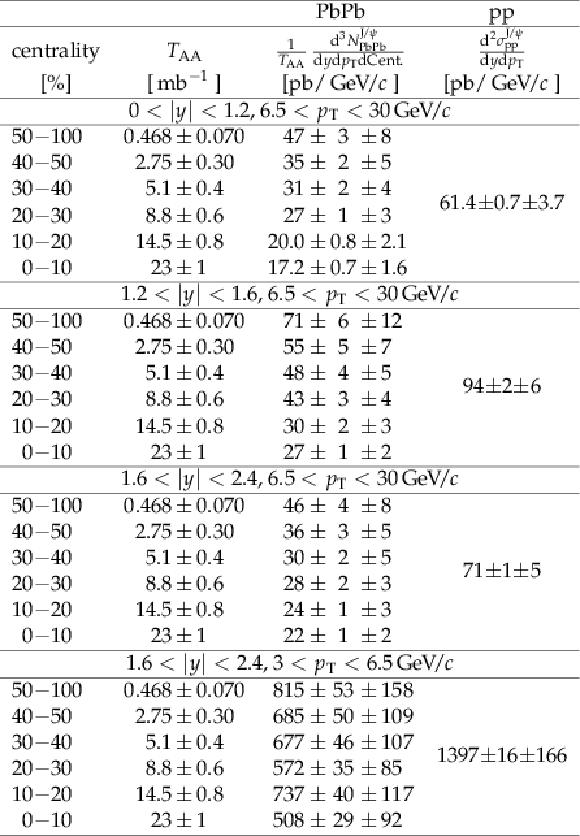
png pdf |
Table 4:
The prompt $ \mathrm{J}/\psi $ fiducial cross section in bins of centrality, for three $ {| y | }$ and two $ {p_{\mathrm {T}}} $ intervals, measured in PbPb and pp collisions at 2.76 TeV within the muon acceptance defined by Eq. (4), and the nuclear overlap function ($ {T_{\mathrm {AA}}} $, with its systematic uncertainty). Listed uncertainties are statistical first and systematic second. A global systematic uncertainty of 3.2% (3.7%) affects all PbPb (pp) fiducial cross sections. The table corresponds to Fig. 5. |

png pdf |
Table 5:
The nonprompt $ \mathrm{J}/\psi $ fiducial cross section in bins of centrality, measured in PbPb and pp collisions at 2.76 TeV within the muon acceptance defined by Eq. (4), and the nuclear overlap function ($ {T_{\mathrm {AA}}} $, with its systematic uncertainty). Listed uncertainties are statistical first and systematic second. A global systematic uncertainty of 3.2% (3.7%) affects all PbPb (pp) fiducial cross sections. The table corresponds to the top panel of Fig. 7. |

png pdf |
Table 6:
The nonprompt $ \mathrm{J}/\psi $ fiducial cross section in bins of absolute rapidity, measured in PbPb and pp collisions at 2.76 TeV within the muon acceptance defined by Eq. (4), and the nuclear overlap function ($ {T_{\mathrm {AA}}} $, with its systematic uncertainty). Listed uncertainties are statistical first and systematic second. A global systematic uncertainty of 6.5% (3.7%) affects all PbPb (pp) fiducial cross sections. The table corresponds to the middle panel of Fig. 7. |
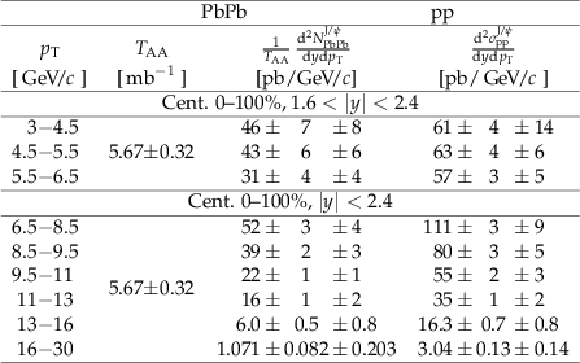
png pdf |
Table 7:
The nonprompt $ \mathrm{J}/\psi $ fiducial cross section in bins of $ {p_{\mathrm {T}}} $, measured in PbPb and pp collisions at 2.76 TeV within the muon acceptance defined by Eq. (4), and the nuclear overlap function ($ {T_{\mathrm {AA}}} $, with its systematic uncertainty). Listed uncertainties are statistical first and systematic second. A global systematic uncertainty of 6.5% (3.7%) affects all PbPb (pp) fiducial cross sections. The table corresponds to the bottom panel of Fig. 7. |

png pdf |
Table 8:
The nonprompt $ \mathrm{J}/\psi $ fiducial cross section in bins of centrality, for three $ {| y | }$ and two $ {p_{\mathrm {T}}} $ intervals, measured in PbPb and pp collisions at 2.76 TeV within the muon acceptance defined by Eq. (4), and the nuclear overlap function ($ {T_{\mathrm {AA}}} $, with its systematic uncertainty). Listed uncertainties are statistical first and systematic second. A global systematic uncertainty of 3.2% (3.7%) affects all PbPb (pp) fiducial cross sections. The table corresponds to Fig. 8. |
| Summary |
|
The production of prompt and nonprompt (coming from b hadron decay) $ \mathrm{J}/\psi $ has been studied in pp and PbPb collisions at $\sqrt{s_{\mathrm{NN}}} = $ 2.76 TeV. The $ {R_{\mathrm{AA}}} $ of the prompt $ \mathrm{J}/\psi $ mesons, integrated over the rapidity range $ | {y} | < $ 2.4 and high $ p_{\mathrm{T}} $, 6.5 $ < p_{\mathrm{T}} < $ 30 GeV/$c$, is measured in 12 centrality bins. The $ {R_{\mathrm{AA}}} $ is less than unity even in the most peripheral bin, and the suppression becomes steadily stronger as centrality increases. Integrated over rapidity ($ p_{\mathrm{T}} $) and centrality, no strong evidence for a $ p_{\mathrm{T}} $ (rapidity) dependence of the suppression is found. The azimuthal anisotropy of prompt $ \mathrm{J}/\psi $ mesons shows a nonzero ${v_{2}} $ value in all studied bins, while no strong dependence on centrality, rapidity, or $ p_{\mathrm{T}} $ is observed. The $ {R_{\mathrm{AA}}} $ of nonprompt $ \mathrm{J}/\psi $ mesons shows a slow decrease with increasing centrality and rapidity. The results show less suppression at low $ p_{\mathrm{T}} $. The first measurement of the nonprompt $ \mathrm{J}/\psi $ ${v_{2}} $ is also reported in two $ p_{\mathrm{T}} $ bins for 10-60% event centrality, and the values are consistent with zero elliptical azimuthal anisotropy, though both nominal values are positive. |
| Additional Figures | |
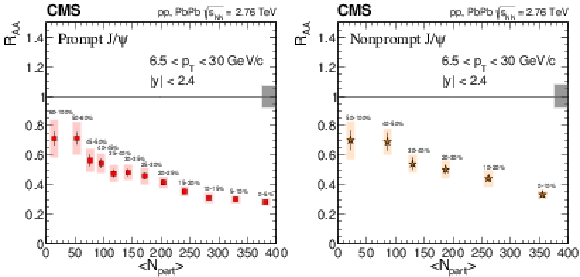
png pdf |
Additional Figure 1:
$ R_{\text {AA}} $ of prompt (left) and nonprompt $ \mathrm{J}/\psi $ (right) as a function of $ {N_{\text {part}}} $ . |

png pdf |
Additional Figure 1-a:
$ R_{\text {AA}} $ of prompt $ \mathrm{J}/\psi $ as a function of $ {N_{\text {part}}} $ . |
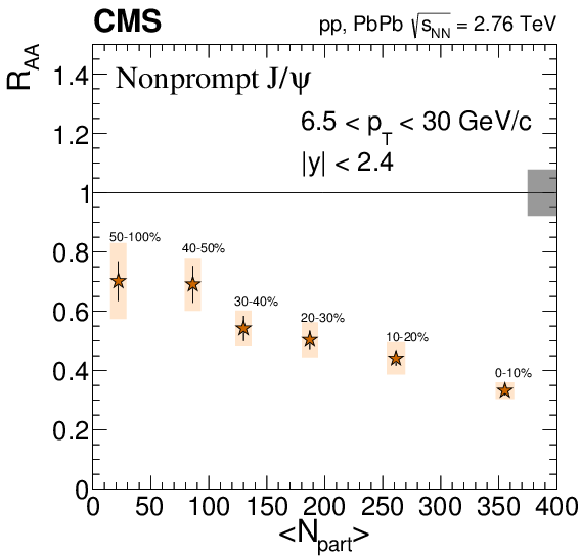
png pdf |
Additional Figure 1-b:
$ R_{\text {AA}} $ of nonprompt $ \mathrm{J}/\psi $ as a function of $ {N_{\text {part}}} $ . |
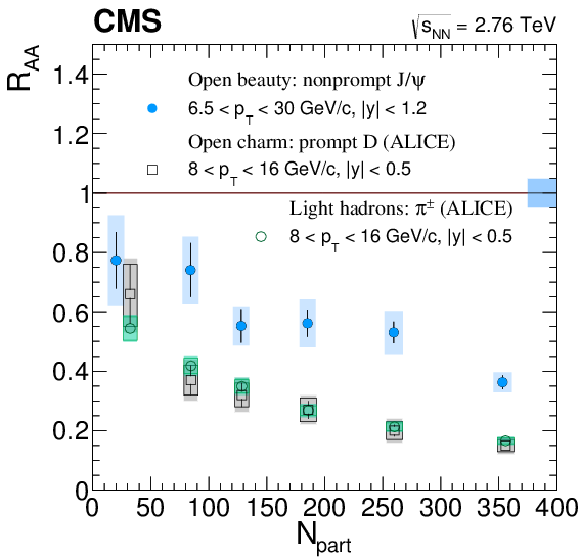
png pdf |
Additional Figure 2:
$ R_{\text {AA}} $ of nonprompt $ \mathrm{J}/\psi $ meson, and D and $\pi ^{\pm }$ meson (ALICE) [1] as a function of $ {N_{\text {part}}} $ . |
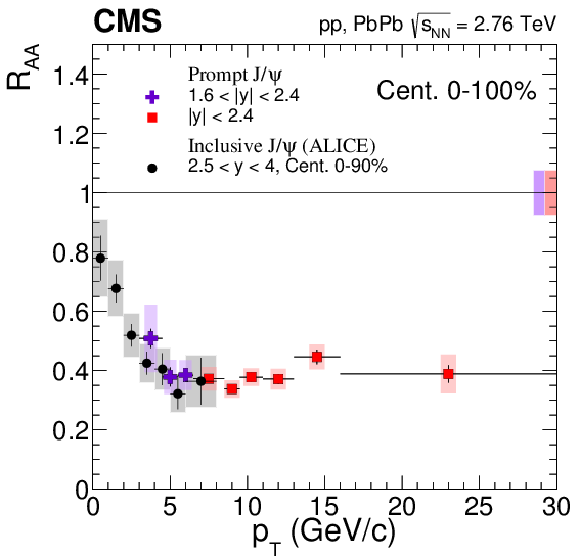
png pdf |
Additional Figure 3:
$ R_{\text {AA}} $ of prompt $ \mathrm{J}/\psi $ and inclusive $ \mathrm{J}/\psi $ (ALICE) [2], as a function of $ {p_{\mathrm {T}}} $ . |

png pdf |
Additional Figure 4:
$ R_{\text {AA}} $ of nonprompt $ \mathrm{J}/\psi $ , charged hadron, and prompt D (ALICE) [3], as a function of $ {p_{\mathrm {T}}} $ . |
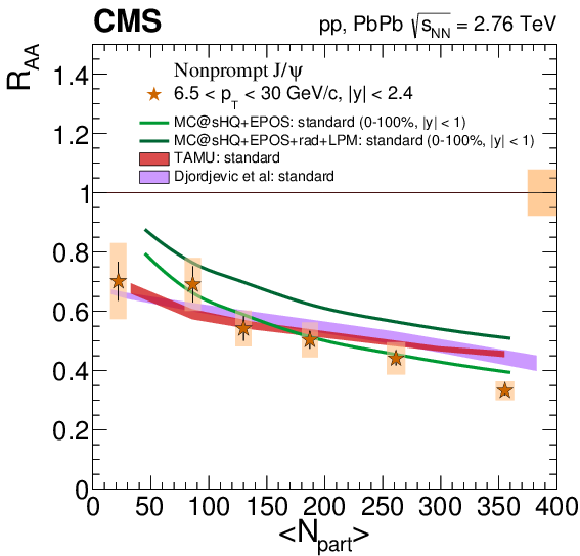
png pdf |
Additional Figure 5:
$ R_{\text {AA}} $ of nonprompt $ \mathrm{J}/\psi $ as a function of $ {N_{\text {part}}} $ for $|y| < $ 2.4, compared to model calculations: MC@sHQ+EPOS [4], TAMU [5], and Djordjevic et al. [6]. |

png pdf |
Additional Figure 6:
$ R_{\text {AA}} $ of nonprompt $ \mathrm{J}/\psi $ as a function of $ {N_{\text {part}}} $ for $|y| < $ 1.2 is compared to model calculations: MC@sHQ+EPOS [4], TAMU [5], and Djordjevic et al. [6]. |
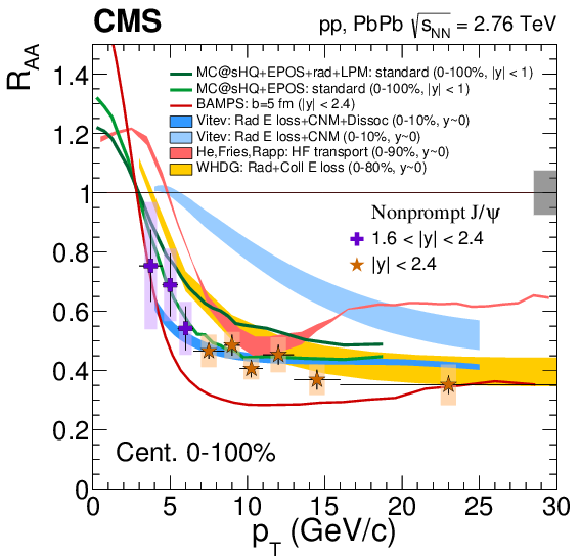
png pdf |
Additional Figure 7:
$ R_{\text {AA}} $ of nonprompt $ \mathrm{J}/\psi $ as a function of $p_{T}$ for $|y| < $ 2.4, compared to model calculations: a) MC@sHQ+EPOS [4] and BAMPS [7], computed for nonprompt $ \mathrm{J}/\psi $ ; b) Vitev [8], HF transport [9], and WHDG [10], computed for B. |
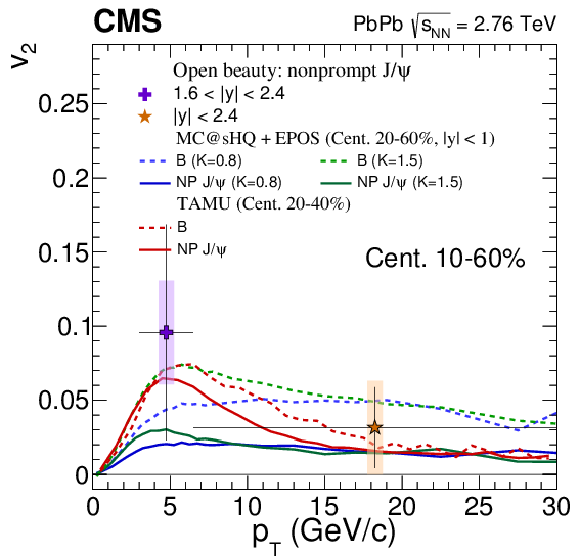
png pdf |
Additional Figure 8:
${v_{2}} $ of nonprompt $ \mathrm{J}/\psi $ as a function of ${p_{\mathrm {T}}} $ , compared to MC@sHQ+EPOS [4] in blue and green curves. TAMU [5] model is presented in red curves. |
| References | ||||
| 1 | A. Andronic et al. | Heavy-flavour and quarkonium production in the LHC era: from proton-proton to heavy-ion collisions | EPJC 76 (2016) 107 | 1506.03981 |
| 2 | E. V. Shuryak | Theory of Hadronic Plasma | Sov. Phys. JETP 47 (1978)212 | |
| 3 | F. Karsch and E. Laermann | Thermodynamics and in-medium hadron properties from lattice QCD | in Quark-Gluon Plasma III, R. C. Hwa and X.-N. Wang, eds World Scientific Publishing Co. Pte. Ltd. | hep-lat/0305025 |
| 4 | T. Matsui and H. Satz | $ \mathrm{J}/\psi $ suppression by quark-gluon plasma formation | PLB 178 (1986) 416 | |
| 5 | Y. L. Dokshitzer and D. E. Kharzeev | Heavy quark colorimetry of QCD matter | PLB 519 (2001) 199 | hep-ph/0106202 |
| 6 | LHCb Collaboration | Measurement of $ \mathrm{J}/\psi $ production in pp collisions at $ \sqrt{s} = $ 7 TeV | EPJC 71 (2011) 1645 | 1103.0423 |
| 7 | CMS Collaboration | Prompt and non-prompt $ \mathrm{J}/\psi $ production in pp collisions at $ \sqrt{s} = $ 7 TeV | EPJC 71 (2011) 1575 | CMS-BPH-10-002 1011.4193 |
| 8 | ATLAS Collaboration | Measurement of the differential cross-sections of inclusive, prompt and non-prompt $ \mathrm{J}/\psi $ production in pp collisions at $ \sqrt{s} = $ 7 TeV | NPB 850 (2011) 387 | 1104.3038 |
| 9 | A. Mocsy and P. Petreczky | Color screening melts quarkonium | PRL 99 (2007) 211602 | 0706.2183 |
| 10 | E. Braaten and M. H. Thoma | Energy loss of a heavy quark in the quark-gluon plasma | PRD 44 (1991) R2625 | |
| 11 | B.-W. Zhang, E. Wang, and X.-N. Wang | Heavy quark energy loss in nuclear medium | PRL 93 (2004) 072301 | nucl-th/0309040 |
| 12 | N. Armesto, A. Dainese, C. A. Salgado, and U. A. Wiedemann | Testing the color charge and mass dependence of parton energy loss with heavy-to-light ratios at BNL RHIC and CERN LHC | PRD 71 (2005) 054027 | hep-ph/0501225 |
| 13 | H. van Hees, V. Greco, and R. Rapp | Heavy-quark probes of the quark-gluon plasma at RHIC | PRC 73 (2006) 034913 | nucl-th/0508055 |
| 14 | S. Peigne and A. Peshier | Collisional energy loss of a fast heavy quark in a quark-gluon plasma | PRD 77 (2008) 114017 | 0802.4364 |
| 15 | S. Wicks, W. Horowitz, M. Djordjevic, and M. Gyulassy | Heavy quark jet quenching with collisional plus radiative energy loss and path length fluctuations | NPA 783 (2007) 493 | nucl-th/0701063 |
| 16 | P. B. Gossiaux, J. Aichelin, T. Gousset, and V. Guiho | Competition of heavy-quark radiative and collisional energy loss in deconfined matter | JPG 37 (2010) 094019 | 1001.4166 |
| 17 | A. Adil and I. Vitev | Collisional dissociation of heavy mesons in dense QCD matter | PLB 649 (2007) 139 | hep-ph/0611109 |
| 18 | R. Sharma, I. Vitev, and B.-W. Zhang | Light-cone wave function approach to open heavy flavor dynamics in QCD matter | PRC 80 (2009) 054902 | 0904.0032 |
| 19 | H. Satz | Calibrating the in-medium behavior of quarkonia | Adv. High Energy Phys. 2013 (2013) 242918 | 1303.3493 |
| 20 | F. Riek and R. Rapp | Quarkonia and heavy-quark relaxation times in the quark-gluon plasma | PRC 82 (2010) 035201 | 1005.0769 |
| 21 | R. Sharma and I. Vitev | High transverse momentum quarkonium production and dissociation in heavy ion collisions | PRC 87 (2013) 044905 | 1203.0329 |
| 22 | CMS Collaboration | Suppression of non-prompt $ \mathrm{J}/\psi, $ prompt $ \mathrm{J}/\psi, $ and $ \Upsilon\mathrm{(1S)} $ in PbPb collisions at $ \sqrt{s}_{\mathrm{NN}}= $ 2.76 TeV | JHEP 05 (2012) 063 | CMS-HIN-10-006 1201.5069 |
| 23 | ALICE Collaboration | Inclusive, prompt and non-prompt $ \mathrm{J}/\psi $ production at mid-rapidity in Pb-Pb collisions at $ \sqrt{s}_{\mathrm{NN}}= $ 2.76 TeV | JHEP 07 (2015) 051 | 1504.07151 |
| 24 | ALICE Collaboration | $ \mathrm{J}/\psi $ suppression at forward rapidity in Pb-Pb collisions at $ \sqrt{s}_{\mathrm{NN}}= $ 2.76 TeV | PRL 109 (2012) 072301 | 1202.1383 |
| 25 | PHENIX Collaboration | $ \mathrm{J}/\psi $ suppression at forward rapidity in AuAu collisions at $ \sqrt{s}_{\mathrm{NN}}= $ 200 GeV | PRC 84 (2011) 054912 | 1103.6269 |
| 26 | ALICE Collaboration | Differential studies of inclusive $ \mathrm{J}/\psi $ and $ \psi\mathrm{(2S)} $ production at forward rapidity in Pb-Pb collisions at $ \sqrt{s}_{\mathrm{NN}}= $ 2.76 TeV | JHEP 05 (2016) 179 | 1506.08804 |
| 27 | X. Zhao and R. Rapp | Medium modifications and production of charmonia at LHC | NPA 859 (2011) 114 | 1102.2194 |
| 28 | A. Andronic, P. Braun-Munzinger, K. Redlich, and J. Stachel | The thermal model on the verge of the ultimate test: particle production in Pb-Pb collisions at the LHC | JPG 38 (2011) 124081 | 1106.6321 |
| 29 | E. G. Ferreiro | Charmonium dissociation and recombination at LHC: Revisiting comovers | PLB 731 (2014) 57 | 1210.3209 |
| 30 | J.-Y. Ollitrault | Anisotropy as a signature of transverse collective flow | PRD 46 (1992) 229 | |
| 31 | ALICE Collaboration | Azimuthal anisotropy of D meson production in Pb-Pb collisions at $ \sqrt{s}_{\mathrm{NN}}= $ 2.76 TeV | PRC 90 (2014) 034904 | 1405.2001 |
| 32 | ALICE Collaboration | $ \mathrm{J}/\psi $ elliptic flow in PbPb collisions at $ \sqrt{s}_{\mathrm{NN}}= $ 2.76 TeV | PRL 111 (2013) 162301 | 1303.5880 |
| 33 | P. Braun-Munzinger and J. Stachel | (Non)thermal aspects of charmonium production and a new look at $ \mathrm{J}/\psi $ suppression | PLB 490 (2000) 196 | nucl-th/0007059 |
| 34 | Y. Liu, Z. Qu, N. Xu, and P. Zhuang | $ \mathrm{J}/\psi $ transverse momentum distribution in high energy nuclear collisions at RHIC | PLB 678 (2009) 72 | 0901.2757 |
| 35 | CMS Collaboration | The CMS experiment at the CERN LHC | JINST 3 (2008) S08004 | CMS-00-001 |
| 36 | CMS Collaboration | Observation and studies of jet quenching in PbPb collisions at $ \sqrt{s}_{\mathrm{NN}}= $ 2.76 TeV | PRC 84 (2011) 024906 | CMS-HIN-10-004 1102.1957 |
| 37 | CMS Collaboration | Luminosity calibration for the 2013 proton-lead and proton-proton data taking | CMS-PAS-LUM-13-002 | CMS-PAS-LUM-13-002 |
| 38 | C. Roland | Track reconstruction in heavy ion collisions with the CMS silicon tracker | in TIME 20005 --- Proceedings fo the 1st Workshop on Tracking in High Multiplicity Environments 2006 | |
| 39 | CMS Collaboration | Description and performance of track and primary-vertex reconstruction with the CMS tracker | JINST 9 (2014) P10009 | CMS-TRK-11-001 1405.6569 |
| 40 | M. L. Miller, K. Reygers, S. J. Sanders, and P. Steinberg | Glauber modeling in high-energy nuclear collisions | Ann. Rev. Nucl. Part. Sci. 57 (2007) 205 | nucl-ex/0701025 |
| 41 | T. Sjostrand, S. Mrenna, and P. Z. Skands | PYTHIA 6.4 physics and manual | JHEP 05 (2006) 026 | hep-ph/0603175 |
| 42 | D. J. Lange | The EvtGen particle decay simulation package | NIMA 462 (2001) 152 | |
| 43 | E. Barberio and Z. W\cas | PHOTOS --- A universal Monte Carlo for QED radiative corrections: version 2.0 | CPC 79 (1994) 291 | |
| 44 | ALICE Collaboration | $ \mathrm{J}/\psi $ polarization in pp collisions at $ \sqrt{s}= $ 7 TeV | PRL 108 (2012) 082001 | 1111.1630 |
| 45 | CMS Collaboration | Measurement of the prompt $ \mathrm{J}/\psi $ and $ \psi\mathrm{(2S)} $ polarizations in pp collisions at $ \sqrt{s} = $ 7 TeV | PLB 727 (2013) 381 | CMS-BPH-13-003 1307.6070 |
| 46 | LHCb Collaboration | Measurement of $ \mathrm{J}/\psi $ polarization in pp collisions at $ \sqrt{s}= $ 7 TeV | EPJC 73 (2013) 2631 | 1307.6379 |
| 47 | CMS Collaboration | Indications of suppression of excited $ \Upsilon $ states in PbPb collisions at $ \sqrt{s}_{\mathrm{NN}}= $ 2.76 TeV | PRL 107 (2011) 052302 | CMS-HIN-11-007 1105.4894 |
| 48 | CMS Collaboration | Observation of sequential Upsilon suppression in PbPb collisions | PRL 109 (2012) 222301 | CMS-HIN-11-011 1208.2826 |
| 49 | CMS Collaboration | Event activity dependence of $ \Upsilon\mathrm{(nS)} $ production in $ \sqrt{s}_{\mathrm{NN}}= $ 5.02 TeV pPb and $ \sqrt{s}= $ 2.76 TeV pp collisions | JHEP 04 (2014) 103 | CMS-HIN-13-003 1312.6300 |
| 50 | CMS Collaboration | Measurement of prompt $ \psi\mathrm{(2S)} \to \mathrm{J}/\psi $ yield ratios in PbPb and pp collisions at $ \sqrt{s}_{\mathrm{NN}}= $ 2.76 TeV | PRL 113 (2014) 262301 | CMS-HIN-12-007 1410.1804 |
| 51 | I. P. Lokhtin and A. M. Snigirev | A model of jet quenching in ultrarelativistic heavy ion collisions and high-$ p_{\mathrm{T}} $ hadron spectra at RHIC | EPJC 45 (2006) 211 | hep-ph/0506189 |
| 52 | GEANT4 Collaboration | GEANT4 --- A simulation toolkit | NIMA 506 (2003) 250 | |
| 53 | CMS Collaboration | Dependence on pseudorapidity and centrality of charged hadron production in PbPb collisions at $ \sqrt{s}_{\mathrm{NN}}= $ 2.76 TeV | JHEP 08 (2011) 141 | CMS-HIN-10-001 1107.4800 |
| 54 | ALEPH Collaboration | Measurement of the anti-B$ ^{0} $ and B$ ^{-} $ meson lifetimes | PLB 307 (1993) 194 | |
| 55 | CMS Collaboration | $ \mathrm{J}/\psi $ and $ \psi\mathrm{(2S)} $ production in pp collisions at $ \sqrt{s}= $ 7 TeV | JHEP 02 (2012) 011 | CMS-BPH-10-014 1111.1557 |
| 56 | M. J. Oreglia | A study of the reactions $\psi' \to \gamma\gamma \psi$ | PhD thesis, Stanford University, 1980 SLAC Report SLAC-R-236 | |
| 57 | CMS Collaboration | Measurement of the elliptic anisotropy of charged particles produced in PbPb collisions at nucleon-nucleon center-of-mass energy = 2.76 TeV | PRC 87 (2013) 014902 | CMS-HIN-10-002 1204.1409 |
| 58 | A. M. Poskanzer and S. A. Voloshin | Methods for analyzing anisotropic flow in relativistic nuclear collisions | PRC 58 (1998) 1671 | nucl-ex/9805001 |
| 59 | CMS Collaboration | Azimuthal anisotropy of charged particles at high transverse momenta in PbPb collisions at $ \sqrt{s}_{\mathrm{NN}}= $ 2.76 TeV | PRL 109 (2012) 022301 | CMS-HIN-11-012 1204.1850 |
| 60 | CMS Collaboration | Performance of CMS muon reconstruction in pp collision events at $ \sqrt{s}= $ 7 TeV | JINST 7 (2012) P10002 | CMS-MUO-10-004 1206.4071 |
| 61 | ALICE Collaboration | Suppression of high transverse momentum D mesons in central Pb-Pb collisions at $ \sqrt{s}_{\mathrm{NN}}= $ 2.76 TeV | JHEP 09 (2012) 112 | 1203.2160 |
| 62 | ALICE Collaboration | Centrality dependence of high-$ p_{\mathrm{T}} $ D meson suppression in Pb-Pb collisions at $ \sqrt{s}_{\mathrm{NN}}= $ 2.76 TeV | JHEP 11 (2015) 205 | 1506.06604 |
| 63 | F. Arleo, R. Kolevatov, S. Peigne, and M. Rustamova | Centrality and $ p_\perp $ dependence of $ \mathrm{J}/\psi $ suppression in proton-nucleus collisions from parton energy loss | JHEP 05 (2013) 155 | 1304.0901 |
| 64 | E. G. Ferreiro | Excited charmonium suppression in proton-nucleus collisions as a consequence of comovers | PLB 749 (2015) 98 | 1411.0549 |
| 65 | H. Fujii and K. Watanabe | Heavy quark pair production in high energy pA collisions: Quarkonium | NPA 915 (2013) 1 | 1304.2221 |
| 66 | ALICE Collaboration | Centrality dependence of inclusive $ \mathrm{J}/\psi $ production in p-Pb collisions at $ \sqrt{s}_{\mathrm{NN}}= $ 5.02 TeV | JHEP 11 (2015) 127 | 1506.08808 |
| 67 | ALICE Collaboration | Rapidity and transverse-momentum dependence of the inclusive $ \mathrm{J}/\psi $ nuclear modification factor in p-Pb collisions at $ \sqrt{s}_{\mathrm{NN}} = $ 5.02 TeV | JHEP 06 (2015) 055 | 1503.07179 |
| 68 | P. Faccioli, C. Lourenco, J. Seixas, and H. K. Woehri | Study of $ \psi\mathrm{(2S)} $ and $ \chi_c $ decays as feed-down sources of $ \mathrm{J}/\psi $ hadro-production | JHEP 10 (2008) 004 | 0809.2153 |
| 69 | LHCb Collaboration | Measurement of the ratio of prompt $ \chi_{c} $ to $ \mathrm{J}/\psi $ production in pp collisions at $ \sqrt{s}= $ 7 TeV | PLB 718 (2012) 431 | 1204.1462 |
| 70 | M. He, R. J. Fries, and R. Rapp | Heavy flavor at the Large Hadron Collider in a strong coupling approach | PLB 735 (2014) 445 | 1401.3817 |
| 71 | ALICE Collaboration | Transverse momentum dependence of D-meson production in Pb-Pb collisions at $ \sqrt{s}_{\mathrm{NN}}= $ 2.76 TeV | JHEP 03 (2016) 081 | 1509.06888 |
| 72 | Y. L. Dokshitzer, V. A. Khoze, and S. I. Troian | On specific QCD properties of heavy quark fragmentation (`dead cone') | JPG 17 (1991) 1602 | |
| 73 | N. Armesto, C. A. Salgado, and U. A. Wiedemann | Medium induced gluon radiation off massive quarks fills the dead cone | PRD 69 (2004) 114003 | hep-ph/0312106 |
| 74 | M. Djordjevic and M. Gyulassy | Heavy quark radiative energy loss in QCD matter | NPA 733 (2004) 265 | nucl-th/0310076 |
| 75 | CMS Collaboration | Evidence of $ b $-Jet Quenching in PbPb Collisions at $ \sqrt{s}_{\mathrm{NN}}= $ 2.76 TeV | PRL 113 (2014) 132301 | CMS-HIN-12-003 1312.4198 |
| 76 | M. Djordjevic | Heavy Flavor Puzzle at LHC: A Serendipitous Interplay of Jet Suppression and Fragmentation | PRL 112 (2014) 042302 | 1307.4702 |

|
Compact Muon Solenoid LHC, CERN |

|

|

|

|

|

|